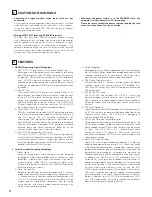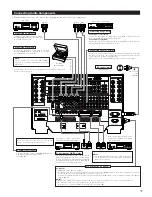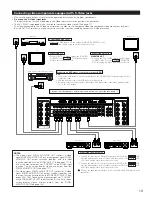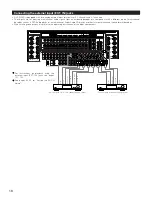
17
The AVC-A1XVA is equipped with a function for up and down
converting video signals.
Because of this, the AVC-A1XVA’s MONITOR OUT terminal can be
connected to the monitor (TV) with a set of cables offering a higher
quality connection, regardless of how the player and the AVC-A1XVA’s
video input terminals are connected.
Generally speaking, analog video connections using the component
video terminals offer the highest quality playback, followed by
connections using the S-Video terminals, then connections using the
regular video terminals (yellow).
The video conversion function
Cautions on the ZONE2 video conversion function:
There is no TBC (Time Base Collector) for ZONE2.
When the component video terminals are used to connect the AVC-
A1XVA with a TV (or monitor, projector, etc.) and the video (yellow) or
S-Video terminals are used to connect the AVC-A1XVA with a VCR,
depending on the combination of the TV and VCR the picture may
flicker in the horizontal direction, be distorted, be out of sync or not
display at all when playing video tapes.
If this happens, connect a commercially available video stabilizer, etc.,
with a TBC (time base corrector) function between the AVC-A1XVA
and the VCR, or if your VCR has a TBC function, turn it on.
The flow of the video signals.
This unit’s input terminals
This unit’s output terminals
(Component video
terminals)
(S-Video terminal)
(Video terminal)
(Component video
terminals)
(MONITOR OUT ZONE2)
(S-Video terminal)
(MONITOR OUT ZONE2)
(Video terminal)
(MONITOR OUT ZONE2)
(HDMI / DVI-D
terminals)
(HDMI / DVI-D
terminals)
: only MAIN ZONE 480i/576i
NOTES:
• It is not possible to down-convert from HDMI and DVI-D input
signals to the component, S-Video or composite video monitor
output terminals.
• Video down conversion to the MAIN ZONE’s monitor output is
only possible when the component video input resolution is 480i
(interlaced standard definition video – NTSC format, for North
America) or 576i (interlaced standard definition video – PAL
format, for Europe and other countries).
• To set the video conversion function for the MAIN ZONE to
“OFF” (See page 72).
• Set the resolution of the video output to one that is compatible
with the resolution of your monitor.
• When “Component” is set at “Scaler” under “HDMI/Component
Out”, the signals are output to the HDMI/DVI-D monitor output
terminal with their original resolution. Use a monitor compatible
with a resolution of 480i/576i.
2
The analog video to HDMI conversion function
• The AVC-A1XVA’s video up-conversion function lets you output
analog video input signals (component – 480i/576i, 480p/576p, 1080i
or 720p; S-Video and composite video - 480i/576i) to the HDMI
monitor output terminal.
• With the AVC-A1XVA, the resolution of the signal output to the
HDMI MONITOR OUT terminal can be selected (See page 69, 70).
The resolutions with which the monitor is compatible can be
checked using the STATUS button on the main unit or the ON
SCREEN button on the remote control unit.
• The resolution of the signal output to the component monitor output
terminal can be set on the AVC-A1XVA.
NOTE:
• If you do not want to use the function for converting analog video
signals to HDMI signals, select “OFF” for “Analog to HDMI
Convert” at “Setting the HDMI/Component out”(See pages 73,
74).
In this case, the function for video up conversion to the
component video terminal operates.
On screen display for component video
outputs and HDMI output
• When viewing component video signals or HDMI signals via the
AVC-A1XVA, the on screen display is displayed on the monitor when
the “System Setup” operations are performed and when the
remote control unit’s ON SCREEN button is operated.
• To view the on screen display using an HDMI monitor, set “Analog
to HDMI Convert” at “HDMI Out Setup” to “ON” (default).
• When only component video signals are input to the AVC-A1XVA,
the characters of the on screen display are not displayed over the
picture.















































